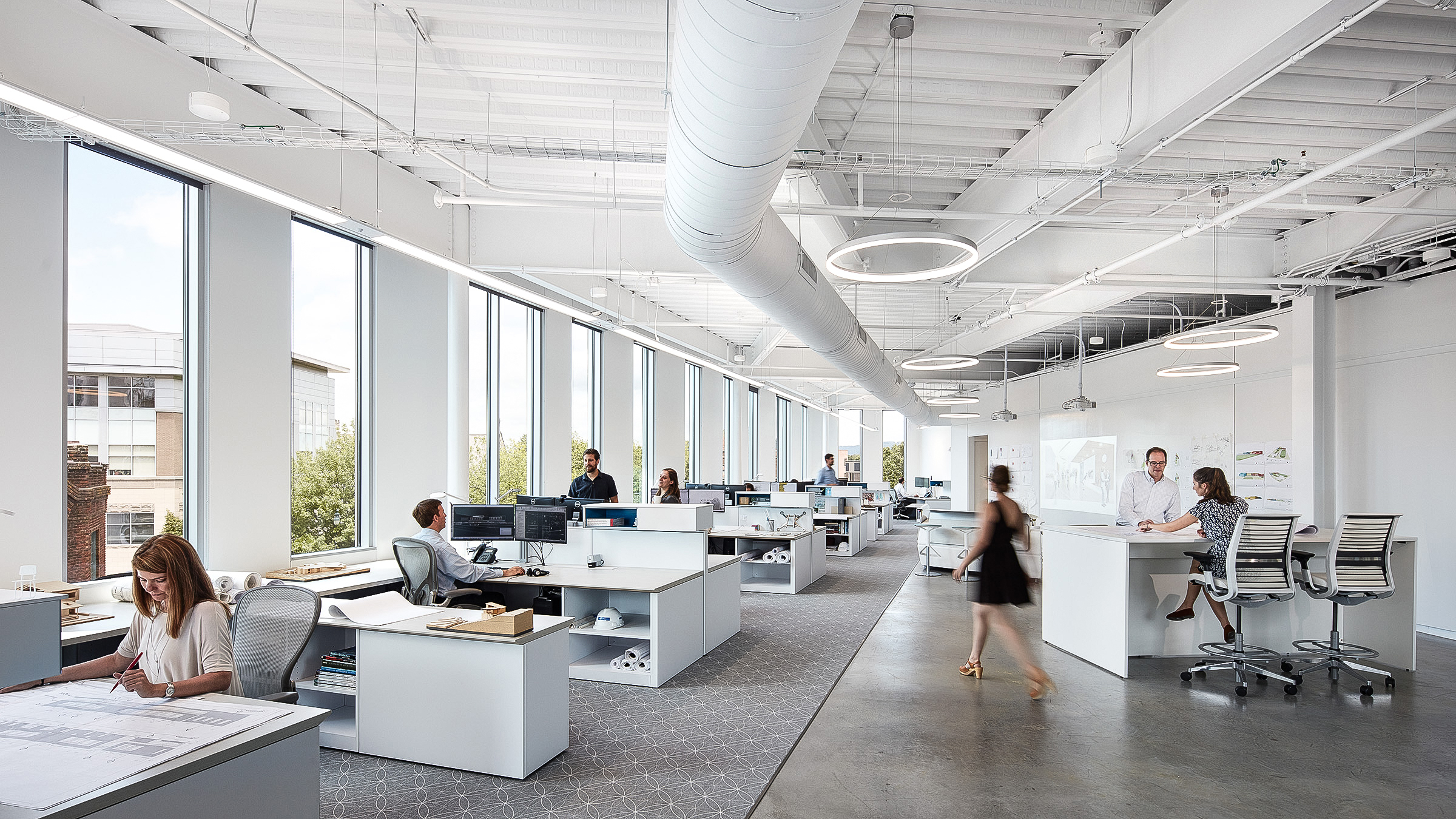Trends in Commercial Workplace Interiors: Q&A with Anne Bradley and Susan Drew

Clark Nexsen’s Anne Bradley and Susan Drew discuss trends in commercial workplace interior design, the primary challenges organizations are turning to workplace design to solve, and how technology is continuing to transform how and where we work.
w
What is (or should be) the impact of workplace design for an organization?
Anne: A workplace should reflect and support the company’s culture, and align with organizational goals. It should be a messenger for the company’s lifestyle and focus. You can’t half do it – for example, a mothers’ room that’s a closet with a chair in it is not demonstrating that you’re taking your workplace where it needs to be. If you’re trying to attract talent, people will see and make judgments based on the design and quality of your space.
Susan: Yes, my answer is very similar. The environment is a big part of your culture. If you want to have a culture that fosters innovation, for example, your workspace and its design needs to foster innovation, too. And there are things you can do to promote that, or things you can mistakenly do that inhibit it. The impact on culture – and as a result, productivity and business goals – is substantial.
Is there a number one thing – or challenge – clients are asking for help with?
Susan: I’ve heard this in almost every kick off meeting we’ve had recently: clients want to create a space where people want to work. It’s about gaining an edge over the competition to get and keep the brightest talent. That requires looking at their space and making it something that is attractive and functional, and has the amenities employees are looking for. “Talent” is definitely the buzzword I’m hearing from every client.
Anne: To build on Susan’s point about attracting talent, one of the challenges our clients ask for help with is the open and collaborative workspaces that younger generations want. It’s about creating effective open space and including the right mix of meeting rooms and sizes. For example, we’re currently designing a new space for WillowTree in Durham, which will transform a historic mill building into a modern office. Creating a mix of collaboration, meeting, and amenity spaces is a central part of the design. It balances the open workspace and offers employees opportunities for privacy or “right-size” meeting rooms depending on the type of work taking place.

Open workspaces with a variety of collaboration and meeting areas foster interaction and enable employees to choose the right location and space depending on how they need to work together.
How is workplace design impacted by the rapid advance of technology?
Anne: As a designer, it’s a challenge to design space that can adapt to ever-changing technology. There’s no question. In the workplace, I see the impact of external mobility being a big factor – giving people the ability and flexibility to seamlessly work from home or in the office.
Susan: I totally agree with Anne. Technology can’t be a source of frustration for employees who are in and out of the office – accessing power and data has to be easy. I also see the impact in terms of furnishings and flexibility. Ten years ago, permanent power in furnishings (like a thick conference room table with power built in) was sought after. But now, I see more of a plug-and-play atmosphere, where spaces have to be very flexible. The infrastructure has to be thoughtfully planned – maybe it’s a grid of floor boxes – and more and more, data is wireless only, not hard-wired. We used to say that systems furniture was flexible… but now that seems laughable. People want things on wheels. Their spaces are literally mobile, so agile teams can reconfigure quickly.
Related Read: Advancing technology and demand for building flexibility are hot topics. Check out “Electrical Systems and Future-Proofing the Built Environment” by Patrick Licklider for a deeper dive.
What is the role (and importance) of change management in terms of the success of a space transformation?
Anne: Fundamentally, change management is about having and distributing correct information. If you don’t, it’s going to create negativity. People hate change because the unknown is scary. I think it’s important to keep people informed about what the plans are and how they’re developing. For example, when I worked on Red Hat’s move to downtown Raleigh while I was with Interior Architects, there were people who were concerned about the safety of downtown. So they held town halls, brought in police officers to discuss downtown, and they answered questions and kept people informed. You’re going to have the most success with a space transformation if you keep people in the loop, and change management is the key to that.
Susan: Absolutely. When people are in the dark, rumors start to flow – so if you don’t communicate the change, it creates opportunity for misinformation. In working with Ferguson on change management, we’ve identified “change champions” within each of the departments. For a large company, it’s difficult to disseminate information effectively to so many people, but the champions play a key role in sharing information and correcting misinformation. They’re an accessible resource for their fellow employees, which complements any communications from leadership.
How are you seeing the allocation of square footage per FTE change?
Susan: Certainly, the square footage devoted to personal space and workstations has decreased, but at the same time, the amount of shared and flexible space is growing. I don’t know that the overall number of square feet per person has gone down as much as people like to say, although the individual space has definitely decreased.
Anne: It also depends on the market you’re in – the function of your daily job impacts whether your space has shrunk, stayed the same, or expanded. I agree with Susan that personal workspace has been reduced. The contrast is the addition of all these other amenity areas. So yes, square footages have reduced and leases have shrunk over the last 10 years, but I think the experience of that is relative given the growth of amenity square footage. A good example is the demand for and function of break rooms. These are happy hour spaces now – they’ve gotten larger and higher end, they’re meant to be inviting. There is also so much more small meeting space than you used to see.
What do you think the future holds for workplace design?
Susan: More and more flexibility. I think we’re going to see a continued change in how much space is committed to people who will work in the office, for example. Once, hoteling was rare – and while it will never be 100 percent – we’re going to see more employees who are in and out of the office. I also see wellness as a growing area. Employees will demand wellness-related amenities more than ever. Another area where I expect continued growth is the creation of spaces for consultants or partners, within a company’s own offices.
Anne: The only constant is change. While leases and footprints are shrinking, the corporate headquarters itself isn’t going away. People want more human experiences; there is so much technology, and we need to create different places to work and have downtime. Also, corporate structures are becoming less hierarchical. Millennials and younger generations want to be part of the conversation and break down silos – and this is going to continue to change the workplace.
Lastly, we can’t overstate the importance of amenities. Employees want attractive, amenity-filled workplaces with a diversity of space types – a real mothers’ room, gender neutral restrooms, and community spaces, to name just a few. Today, amenities and aesthetics take precedence over the allocation of space.
To learn more about our design philosophy and expertise in creating exceptional work environments, please see our Workplace Interiors practice.
Anne Bradley, IIDA, joined Clark Nexsen as vice president of workplace interior design in 2018. She left the firm in 2021.
Susan Drew, CID, IIDA, LEED AP BD+C, is a principal with Clark Nexsen and the leader of our Interiors Studio. With more than 25 years of design experience, she has specialized expertise in the design of workplace interiors. To speak with Susan, please call 757.455.5800 or email sdrew@clarknexsen.com.
